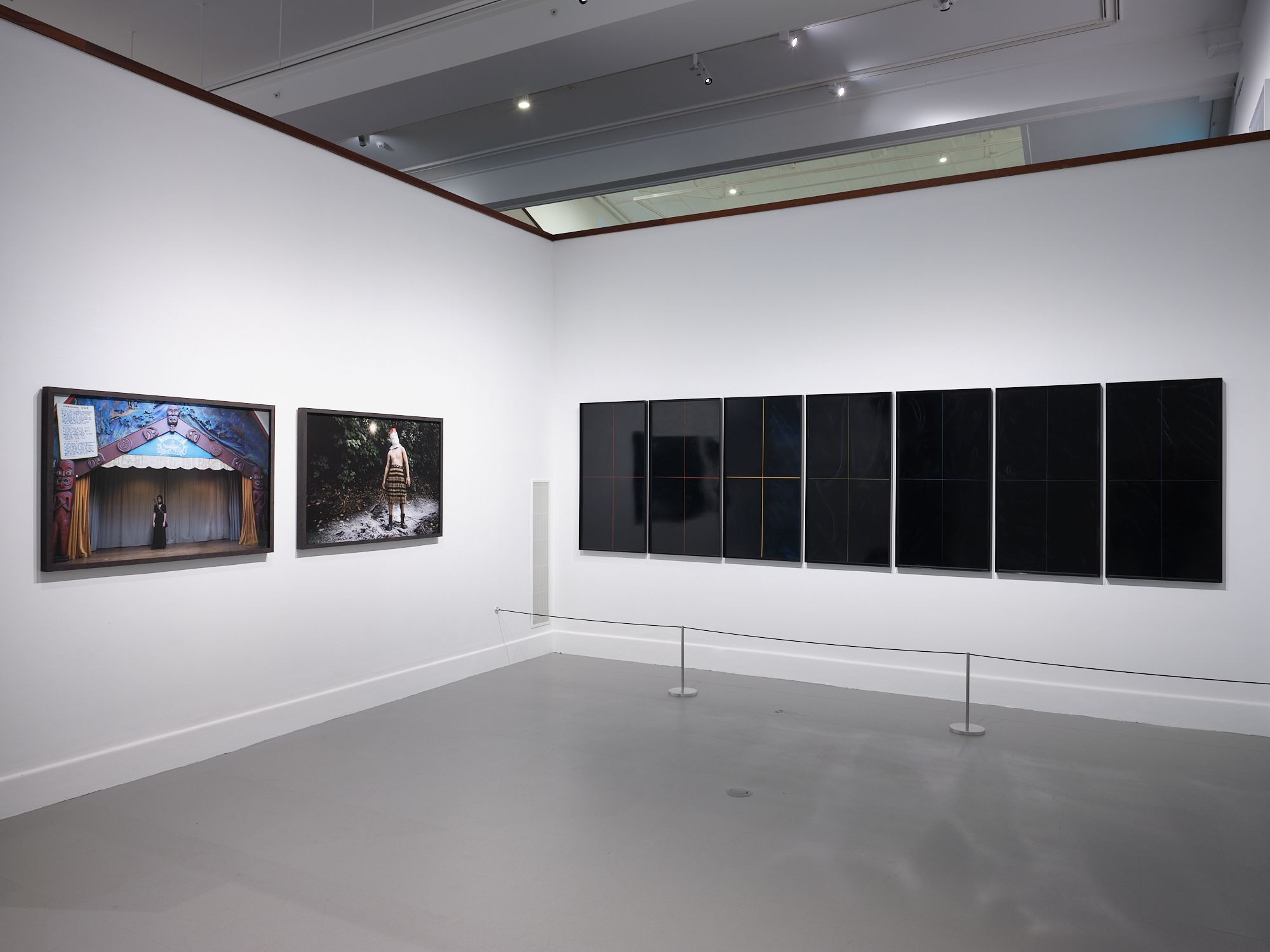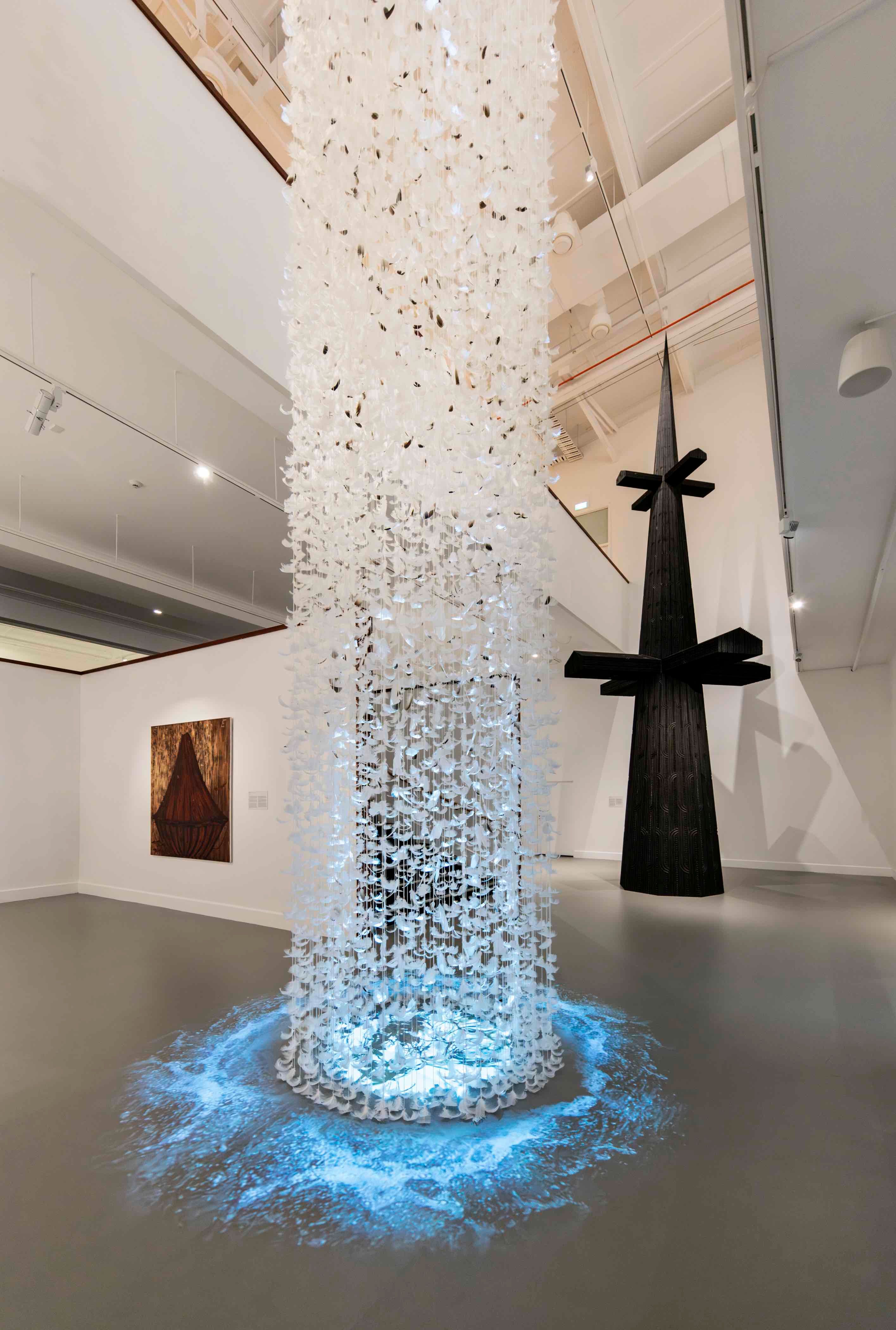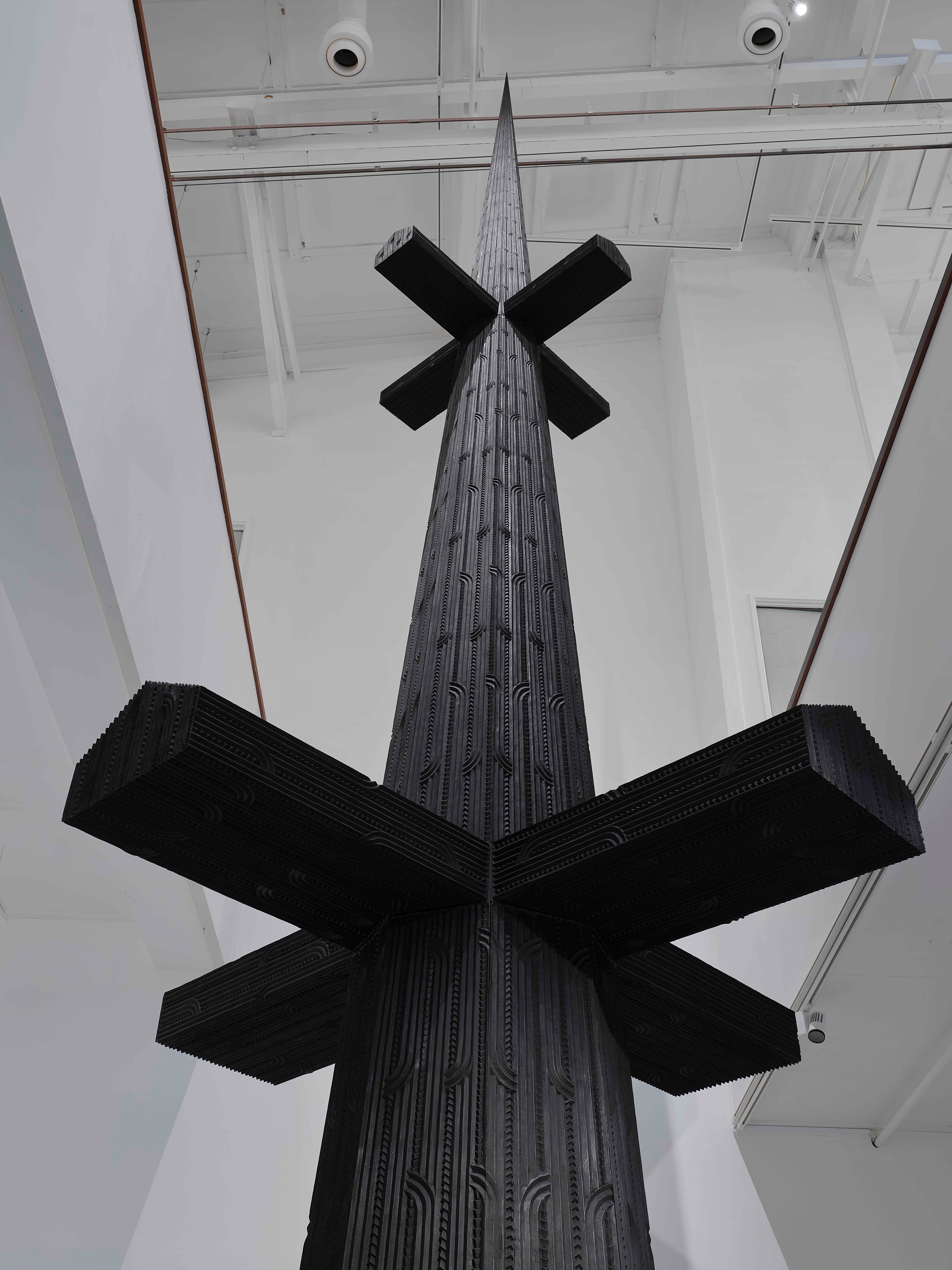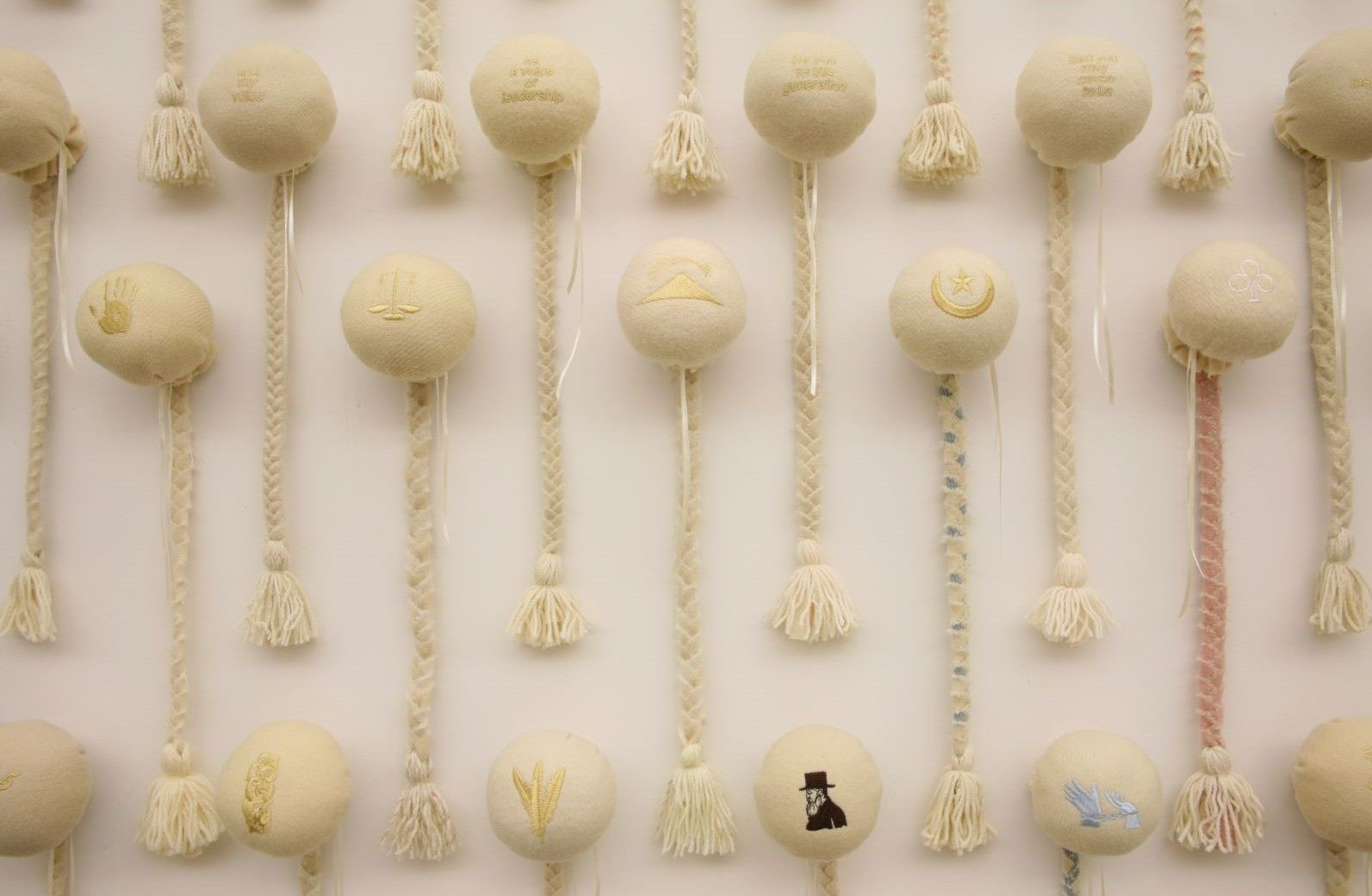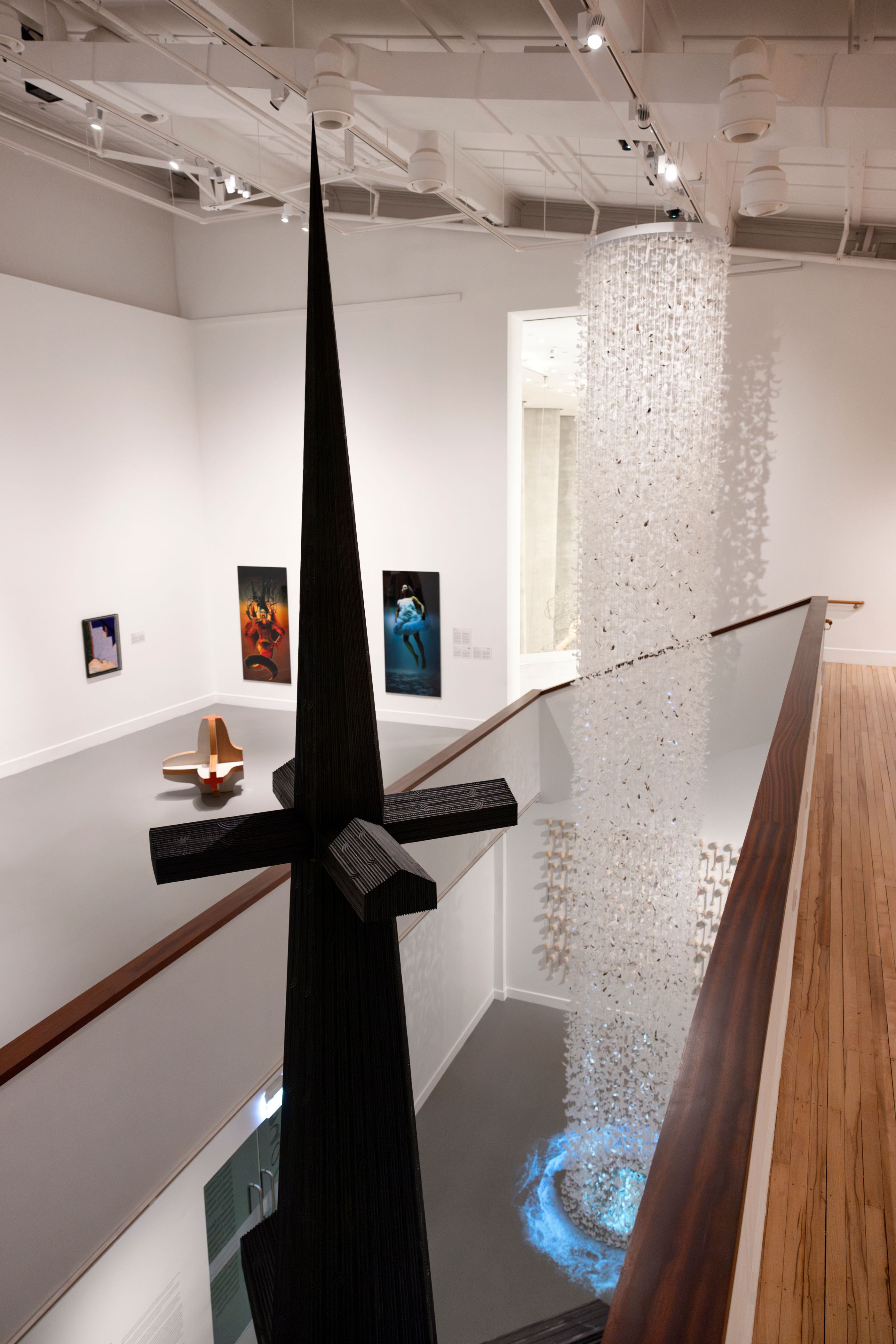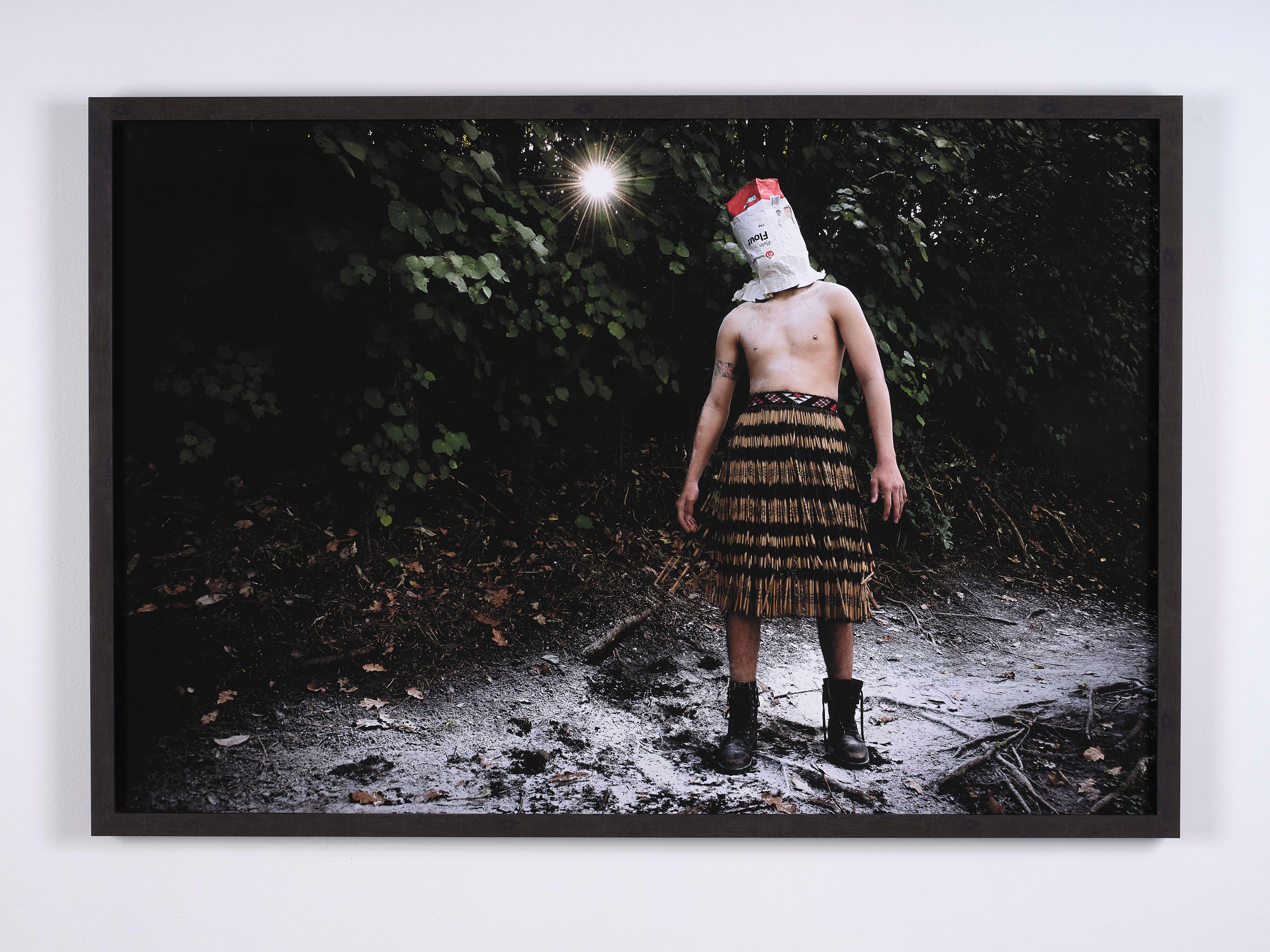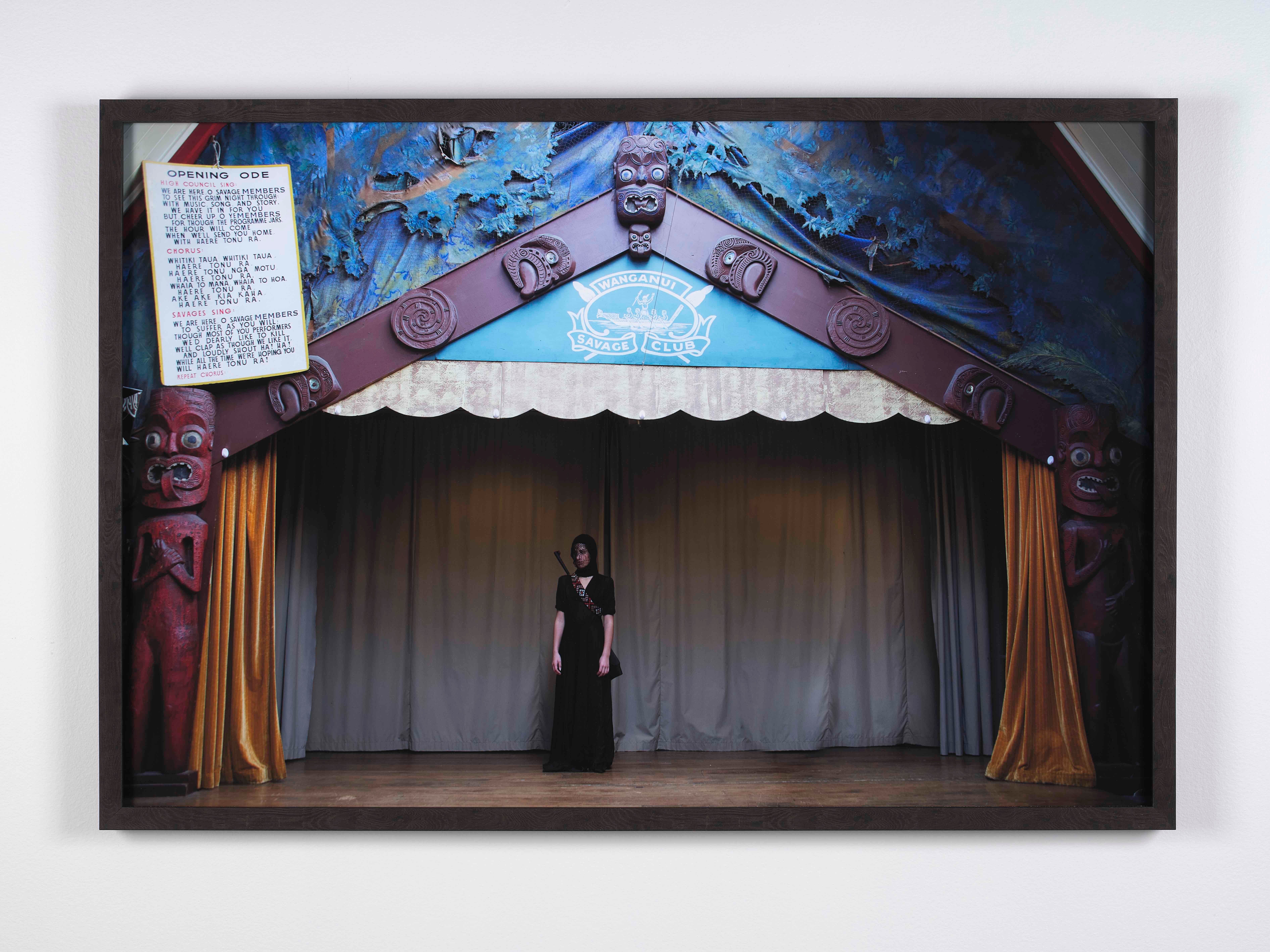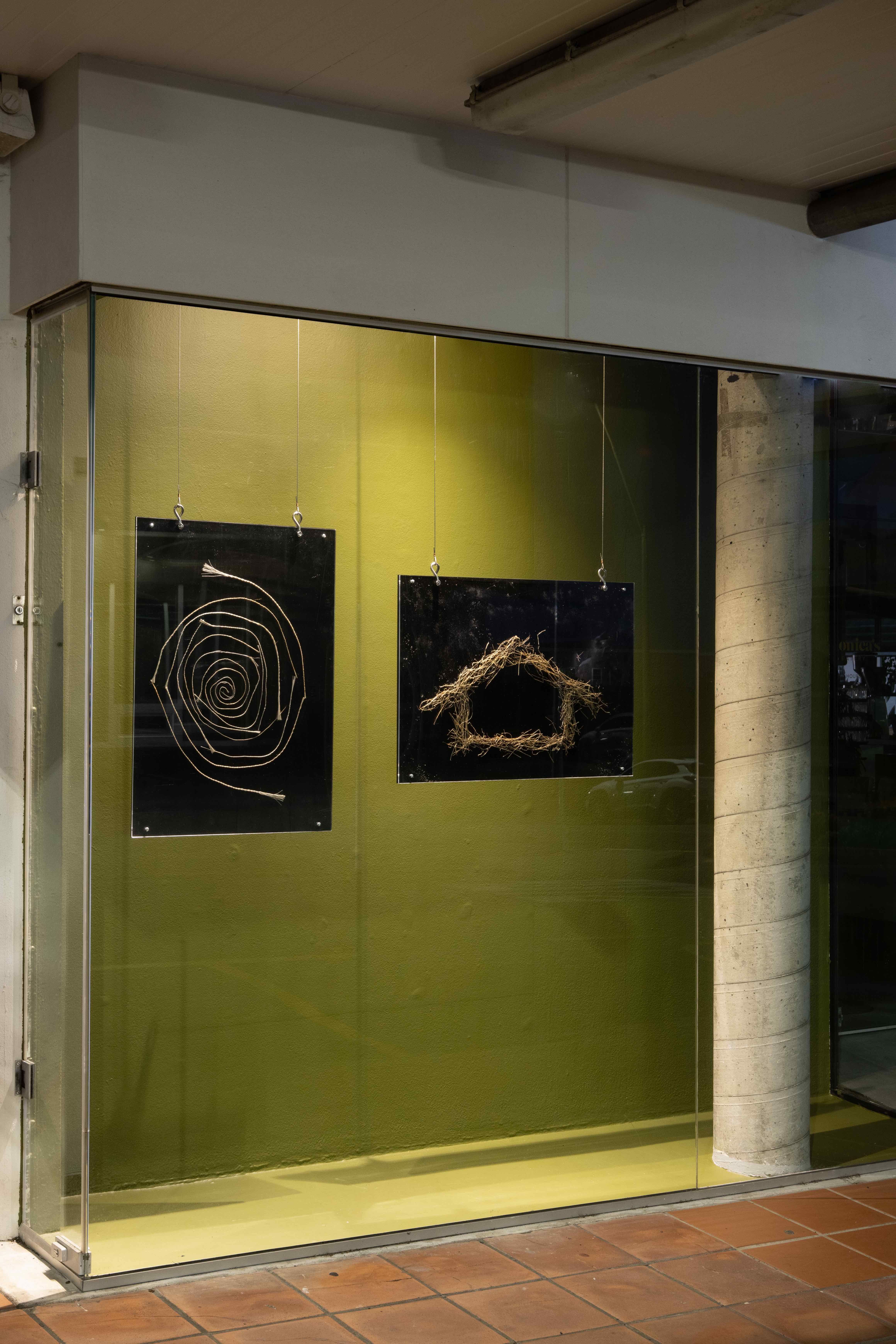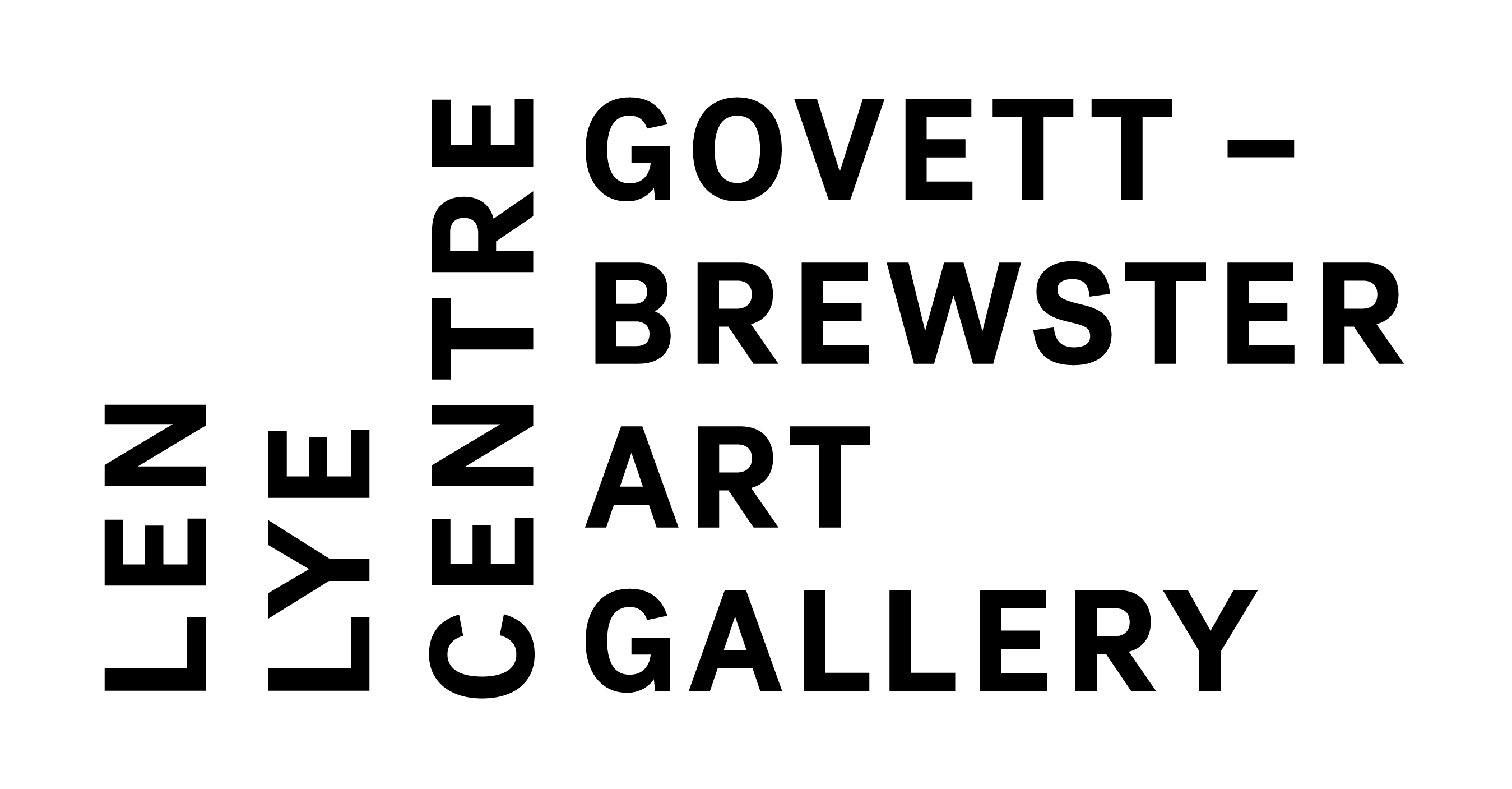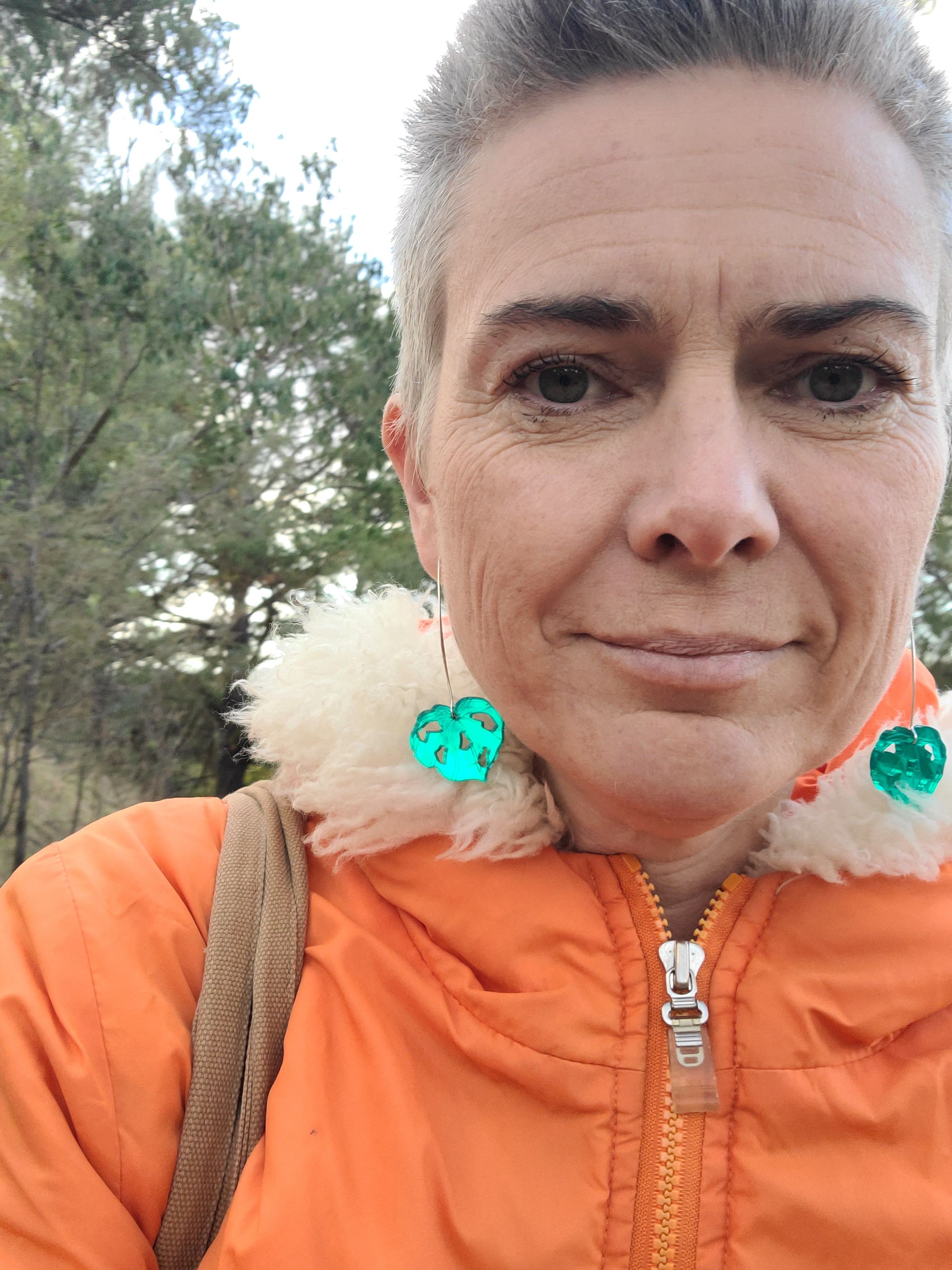Te Hau Whakatonu: A Series of Never-Ending Beginnings
Art stimulates memory and makes us remember who we are. Emma Hislop reflects on the Māori art canon and questions the inclusivity of art galleries during a visit to The Govett-Brewster Art Gallery.
TW: Sexual assault
The Govett-Brewster Art Gallery is an imposing building since the Len Lye Centre was built – flashy mirrors tower into the sky and there’s a gift shop that visitors must enter to access the gallery. Unfortunately, in 2019 the council decided to charge out-of-town visitors an entry fee of $15. That amount of money isn’t available to everyone. And art should be free.
In Gallery One at the Govett-Brewster, a baby is crawling along the floor beneath thousands of white toroa feathers floating and shifting – the threads forming a cylindrical shape above her. But she’s mesmerised by a watery moving image twisting and folding into itself on the floor. This is Ngahina Hohaia’s (Taranaki iwi, Parihaka Ngāti Moeahu, Ngāti Haupoto) latest work, He Ara Uru Ora (2023). It’s so tall, so elegant. Its pull is strong, a direct presence. I have an urge to climb inside, the feeling that it would be cleansing. Around the baby, people stand admiring the work, sit on the stairs leading up to the next level, talking and laughing. I recall how grateful I was for the close proximity of The Dowse Art Museum in Te Awa Kairangi ki Tai after I had my son, attempting to keep myself sane in the absence of any other creative outlet. It was free entry. The kids’ room had comfy sofas and you could smuggle in a takeaway coffee.
Installation view of Te Hau Whakatonu, A Series of Never-Ending Beginnings, 5 August 2023 – 11 February 2024, Govett-Brewster Art Gallery Len Lye Centre, New Plymouth. Left to right: Shane Cotton, Untitled, 1994; Ngahina Hohaia He Ara Uru Ora (detail), 2023; Brett Graham, Cease Tide of Wrong-Doing, 2020. Photo: Tania Niwa.
He Ara Uru Ora is gigantic and exquisite, 11 metres ceiling to floor in height, met by a circular moving image of whitewash and pale-blue iridescence on the floor. A sound is coming from inside the channel of feathers, like an invitation to step inside. Taonga pūoro – pūrerehua, porotiti, kōhatu. The sound ebbs and flows. There is also the sound of water from Taranaki Mauka, and the call of manu, but slowed down. It makes me think of weddings, or rituals. It’s the bursting of water after being held in. It pours out of the ceiling into a circular pool of moving image, but rather than the pool punctuating the end of the waterfall or flow, I imagine it winding past, or carrying on. As I stand in front of He Ara Uru Ora, a memory resurfaces. Scrubby bush and a dirt shelf abruptly end at the water’s edge. The water is enticing, looks refreshingly cool, the swimming hole shaded by cliffs for a good part of the day. The other kids perch on the high cliff-ledge on the opposite side, soaking up the afternoon sunlight hitting the cliff face. The ground is warm through my togs. One by one, the kids quickly drop into the dark abyss. Some dive deep in search of the bottom, others float on the surface around the gorge.
That’s what art does, it stimulates memory and makes us remember who we are. Or maybe that’s what water does. Water has mauri. But the base of He Ara Uru Ora is the opposite of a dark abyss, it’s blue and translucent, moving outwards and seeming to take me with it. My gaze gradually drifts skyward with the white feathers that form a diving channel to the ceiling. It’s fresh and crisp and seems to contain all things – the life-giving wai from Taranaki Mauka, Tāwhirimātea, Tāne Mahuta, Tangaroa, all of the atua. It’s steeped in the elements, but it feels transcendental. The work takes its title from an expression in Taranaki karakia, a statement for pathways towards healing and regeneration. Each huruhuru toroa could be a kupu, or kete of knowledge, handed down over generations. Ngā kōrero tuku iho.
The ground is warm through my togs. One by one, the kids quickly drop into the dark abyss.
While looking at He Ara Uru Ora, I’m also acutely aware of Brett Graham’s work Cease Tide of Wrong-Doing (2020) tall and monumental behind me. Like Hohaia’s, this artwork towers three floors. It stands directly opposite, in raw black and carved with an intricate pākati, tapering to a needle-like point and winged with model pātaka. This is a niu pole, of the Pai Mārire faith, used to divine messages of war and peace. Niu were customarily raised in times of intense colonial violence. This artwork shows me how historic wounds continue to weep.
There is a relationship between the two works. They create a balanced entrance into the exhibition. Side by side, Cease Tide of Wrong-Doing and He Ara Uru Ora complement and contrast with each other: black/white; solid/light; Tainui/Taranaki. Each has an immediate physical presence. But it’s the sense of stillness that pervades both that keeps me coming back.
Brett Graham, Cease Tide of Wrong-Doing (detail), 2020.
Ka pari te tai moana, ka timu te tai tangata. This whakatauākī – first spoken in 1822 by Ngāti Toa chief Te Rauparaha to Te Wherowhero – acted as an epigraph for Graham’s exhibition Tai Moana Tai Tangata, where Cease Tide of Wrong-Doing was first shown in this space. The work speaks to relations between Māori, the structures of settler colonialism in Aotearoa, and economic and ecological exploitation – Taranaki being the only oil and gas producing region in Aotearoa.
Taraati Taiaroa and the Govett-Brewster recently raised the money to purchase Graham’s work for the collection. I was passing through Ōtautahi when Cease Tide of Wrong-Doing was shown at Christchurch Art Gallery Te Puna o Waiwhetū, but something held me back from going to see it there. My gut feeling was it belongs here in Taranaki, perhaps due to Graham’s connections to Parihaka and the way it speaks to Hohaia’s work. Both feel interconnected through mamae and restoration.
The work speaks to relations between Māori, the structures of settler colonialism in Aotearoa, and economic and ecological exploitation – Taranaki being the only oil and gas producing region in Aotearoa.
I went to secondary school here in Taranaki and we weren’t taught any local history, until a noho at Parihaka in the sixth form. I took history as a subject and they taught us about both World Wars. But I knew of Parihaka. My dad is Māori, and he first visited when Michael King and Barry Barclay were trying to convince the marae to let them make a film as part of the Tangata Whenua series, in the early 1970s. And I grew up 30 minutes away from the marae. Learning the history of Parihaka was still shocking. I can remember saying to my friend Kel, also Māori, “How come we’re just finding out about this now?”
Ngahina Hohaia, Roimata Toroa (installation view), 2006. Govett-Brewster Collection. Photo by Sam Hartnett.
Ngaropi Raumati (Ngāti Mutunga, Ngāti Kahungunu ki Wairoa) is a person of small stature, but she is a strong presence at the Mana Wāhine talk I attended at the Gallery, scheduled in response to Ngahina Hohaia’s work in Te Hau Whakatonu. A toroa feather is tucked into the back of her hair. This is a sovereign space. She says, “If you whakapapa Taranaki or are wāhine Māori, resistance to oppression is in your DNA.” Raumati describes a conversation she recently had with two wāhine about the Govett-Brewster.
“Oh, there’s an art gallery there,” one of the women said. “Are we allowed in?”
“I’ll just leave that with you,” Raumati says, looking hard at the gallery director.
Raumati’s talk raises the questions of not only who art galleries are for, but, more importantly, how to ensure all Māori feel welcome to come inside and view an all-Māori show. Like Toi Tū Toi Ora (2020–21), Te Hau Whakatonu is a testament to the monumental shifts occurring in Māori art. Yet this lived experience declares that Māori continue to be left out of collections and spaces. Whanaukataka doesn’t cost anything. For Māori and Pacific artists, who are already underserved in art institutions, does the canon become another barrier to navigate, another layer of inequity?
When Nigel Borell (Pirirākau, Ngāi Te Rangi, Ngāti Ranginui, Te Whakatōhea) resigned from Auckland Art Gallery Toi o Tāmaki, an important line was being drawn, as an assertion of tino rangatiratanga that demanded our institutions deal with how they share power. When Taarati Taiaroa (Te Āti Awa, Ngāti Tūwharetoa, Ngāti Apa) started at the Govett-Brewster last year in the newly established role of Ringahāpai Kaitakatū Ngā Toi Māori, she did a stocktake to research the whakapapa of toi Māori representation at the gallery. It is worth mentioning that Taiaroa had previously worked alongside Borell on Toi Tū Toi Ora, the largest survey of contemporary Māori art ever undertaken.
For Māori and Pacific artists, who are already underserved in art institutions, does the canon become another barrier to navigate, another layer of inequity?
What Taiaroa discovered at the Govett-Brewster was that a whakapapa of relationships and exhibition histories was represented in the collection, but the collection was also incomplete. Ruth Buchanan (Te Āti Awa, Taranaki) had already exposed the power dynamics behind canonisation in her 2022 exhibition of the collection, The scene in which I find myself / Or, where does my body belong. We know those in power have historically valued white artists more highly than Indigenous ones, and men more highly than women. Of the 900 or so works in the Govett-Brewster permanent collection, there were only 67 Toi Māori pieces. And of the 237 different artists hosted by the gallery, only 23 were Māori.
I’ve visited Te Hau Whakatonu numerous times since the show opened in August last year and I always find myself returning to Gallery One. Many of the works in the rest of the exhibition are by familiar artists. Fiona Pardington, Shane Cotton, Darcy Nicholas, Robin White, Peter Robinson, Michael Parekōwhai, Wayne Youle. Why are they familiar? Is this the Māori canon? It is a good thing that we have Māori artists so established. But that’s what a canon does, it makes artists feel familiar to you, the ones who make the grade. By whose admission?
Hohaia’s work is contrasting, not just to the rest of the show, but to Graham’s. Yet somehow the two works are in conversation. Graham has connections to Parihaka, where Hohaia is from. In this space, these individual works form a pair; both are part of an ongoing kōrero, not just consigned to the canon, or to art history.
Ana Iti, Ayesha Green and George Watson are younger artists with work in the show. They are the up-and-coming kaitoi, and perhaps this is the function of the canon, to give them something to aspire to, to be inspired by. It must be a cool thing to share gallery space with all these art legends. And these legends are looking out for the next generation.
Ma te wahine ka tapu ai to hanga nei, te tangata, ma te whenua kawhai oranga ai / Woman found raped, wrapped in a threadbare cloak.
Shona Rapira Davies’ drawings are made in pencil on paper, and initially made me think of my work as a life model while I was a student at Massey University in Papaioea. The money was decent, but I was often asked to pose in confronting ways – for example, riding a bike or flying a kite – and the art studio was cold in the winter. I was 18. At break time, I’d put a robe on and wander around, fascinated by the different depictions of my body. It was only a year previously at a university orientation toga party that I’d woken up on a strange hostel-room floor, without my toga. The Tall Dwarfs had played.
Rapira-Davies made these drawings for a performance installation at the Govett-Brewster Art Gallery in May 1987 titled Ma te wahine ka tapu ai to hanga nei, te tangata, ma te whenua kawhai oranga ai / Woman found raped, wrapped in a threadbare cloak. During the performance a woman was covered in clay and framed in mānuka sticks to represent tapu – a comment on colonisation’s oppression of Māori women. Rapira-Davies not only deals with colonisation in much of her work, but rape culture and domestic violence; she grapples with the problems of talking about these, which is something I have grappled with in my fiction. Tū Tama Wāhine o Taranaki comes to mind again, a safe and inclusive space for all women, and the wāhine who asked if they were allowed inside the gallery. I can hear the sound of He Ara Uru Ora from here, bleeding into this space and enveloping this work.
Installation view of Te Hau Whakatonu, A Series of Never-Ending Beginnings, 5 August 2023 – 11 February 2024, Govett-Brewster Art Gallery Len Lye Centre, New Plymouth. Photo: Tania Niwa.
Much of Ralph Hōtere’s (Te Aupōuri) work prompts memories. Why is this? In Black Painting 1-7 (1968–69) there are large fields of black; te kore, then te pō. The series of seven paintings hangs in a line five metres long, beside Tia Ranginui’s photographs. The paintings play tricks on me, the fields of black broken up by fine lines made in the colours of the rainbow, which together create light. I can’t figure out what is a smudge, what is a light beam or reflection. The surfaces reflect light, but also absorb it, and in doing so absorb all that comes with light – birth and death, celebration and mourning. I can see myself.
Since my book Ruin was published last year, I’ve been asked to talk publicly about it. The making of the work and the talking about the work are entirely different things. It interests me how readers and viewers decide what the work is about, but that isn’t the work. In an interview, I read that Hohaia has at times felt constrained by viewers pigeon-holing her work as “about Parihaka”. Apparently Hōtere was ambivalent about labels and preferred to let the mahi speak for itself.
Ralph Hotere, Black Painting 1-7, 1968-1969. Govett-Brewster Collection. Photo: Sam Hartnett.
Hōtere’s paintings make me long for Ōtepoti. The last time I was there was with Dad and my sister in 2022. It was October and snowing, not swimming weather. One day we drove to Moeraki and over the hill, where a gravel road leads to a place called Bottom Kaik. Dad tells us Hōtere and whanauka Keri Hulme both had cribs there for many years. He says he and Mum nearly bought a crib there once, but didn’t, and my sister and I look at each other like wtf, why didn’t you buy it? It feels increasingly crucial to spend time on Kāi Tahu whenua. Dad points out the crib, its front door opening literally onto the sand. We both shake our heads at him before walking down the beach.
I went to another talk, given by Tia Ranginui (Ngāti Hine Oneone) at the Govett-Brewster as part of Opening Weekend. I’ve been a fan of her photographs for some time. She was visibly uncomfortable. She hates public speaking, said she wished she had brought a hip flask of something to dull the anxiety. I know those feelings too well.
Tia Ranginui, The intellectual POISONING of a savage mind, 2015. Collection Govett-Brewster Art Gallery, New Plymouth. Gift of the Artist. Photo: Sam Hartnett.
Ranginui’s work makes me uncomfortable – part of the reason I admire it. There is no cheery nostalgia here. The disguise the man is wearing feels like a hideous joke, or racist mockery. But the way he’s standing is confident, like he’s challenging the viewer. This isn’t easy to do with a bag on your head. This work raises a lot of questions. What is going through this man’s mind? Why is he wearing a bag over his head? Against the background of kawakawa bushes, Ranginui seems to subvert a caricature of the Māori warrior dressed in puipiu. The Intellectual Poisoning of the Savage Mind (2015) was made in response to the poisoning of the Whanganui awa through the lacing of flour and sugar with arsenic. In the second photograph, an armed ‘rebel’ takes centre stage in the Whanganui Savage Club. The model is standing solemnly in a pensive mood, hands by her side and rifle slung on her back. There’s an implication that this rebel has taken over the building, but Ranginui was simply handed the keys. Whanganui is Ranginui’s hood and a feature of the self-trained artist’s work. She intentionally showed these works in her first solo show in 2015, out of a personal need to address difficult histories before making further work.
Tia Ranginui, The intellectual PROPERTY of a savage mind, 2015. Collection Govett-Brewster Art Gallery, New Plymouth. Acquired through the Govett-Brewster Foundation with the support of Grant Kerr. Photo: Sam Hartnett.
On the other side of the wall from Ranginui’s photographs is Hohaia’s 2006 work, Roimata Toroa, composed of 395 poi, beautifully made from woollen blankets and ribbon, and embroidered with symbols presenting narratives associated with Parihaka’s movement of non-violent resistance to invasion and confiscation. The significance of the blankets is implicit in the symbolism of the work, but these poi are markers of mana whenua.
When the crown invaded Parihaka, the men were taken to Ōtepoti, where my whānau on Dad’s side are from. The women and children stayed, carried on. Hohaia’s work is part of something bigger: an art movement that celebrates Māori ritual, at a time when the new National Government is intent on attempting to deny and erase us.
A friend recently reminded me that when we heal our trauma we are sending it seven generations back and seven generations forward… that’s a lot of release. How do you even go about healing trauma?
I’ve been dreaming of the local Taranaki river where we swim most days in summer. Rivers have always been gathering spots
Water is healing. For months over winter, I’ve been dreaming of the local Taranaki river where we swim most days in summer. Rivers have always been gathering spots. The river is not our awa. We are not mana whenua here. It’s a family ritual, adapted over the years to accommodate sleeping babies, anxious dogs and now, aged, our increasingly frail mother. She can no longer climb the steps to the beach, so one of us drives her down the road to the other side, where entering the water is slightly easier. Our kids, bigger now, can swim across to meet Nanny. Yesterday my mum said she wouldn’t be able to swim after her hip replacement. “For how long?” I ask. “We’ll find out.”
Water is important to my family, perhaps mostly to my dad, who always chased waves, even went to Hawai‘i to surf bigger ones. There were no other Māori surfers in the early 60s. He started shaping boards in 1971, and in 1973 it was John Bevan Ford who designed the logo for Dad’s Tangaroa boards.
There is a Māori canon – or is it just my Māori canon? One of my art teachers at Massey was Gary Whiting, Cliff Whiting’s son, and we studied Hōtere, Cliff Whiting, John Bevan Ford, Selwyn Muru, Paratene Matchitt, Cath Brown, Fred Graham, Mere Harrison, Katarina Mataira, Buck Nin, Muru Walters, Marilynn Webb, Selwyn Wilson and Arnold Manaaki Wilson. It was the mid-90s and I was 18. We travelled to Pōneke on a bus to visit the Dowse and the National Gallery. We went to Kaikōura for a noho at Takahanga Marae. We sat out the front of the wharenui overlooking the sea, and it was sunny and we worked on our art projects. Under Whiting’s tuition, we had the freedom to create our own aesthetic and infrastructure for our upcoming shows.
We sat out the front of the wharenui overlooking the sea, and it was sunny and we worked on our art projects.
Last week I received a text from Tui Ora. A counsellor had referred me and they offered a free mirimiri. I drove out there, and I felt my shoulders hunched up. I left my shoes in the car. I hadn’t noticed the building before and Hannah, the woman at the desk, told me they’d only been open since June. A woman in the waiting room said kia ora and told me she loved my Xoë Hall sweatshirt and asked where I got it, and I said Xoë was whanauka and we both smiled. I was already feeling better. The room was luxurious, and I stripped to my knickers and lay down on the table with my face in the hole and covered myself with a thick, heated towel and waited. Hannah told me it was up to me whether I wanted to talk or not and I didn’t, but it felt rude not to exchange a couple of pleasantries, even though she’d given me permission not to. We talked about where we came from, our kids, trying to fund Christmas. As she massaged my sore body, she talked about the importance of self-care and being kind to myself. About healing. I asked her if she knew about He Ara Uru Ora at the Govett-Brewster. She didn’t.
Installation view of George Watson: Open Window, 5 August 2023 – 11 February 2024, Govett-Brewster Art Gallery Len Lye Centre, New Plymouth. From left to right: George Watson, Piko rauru, 2023; George Watson, Rikoriko, 2023. Photo: Bryan James.
We go camping in North Taranaki because it’s only $8 per night and our kid is nine but has never slept in a tent. This is Ngāti Mutunga whenua. The campsite is a paddock surrounded by farmland. It’s attached to an old school and the kids stay in the pool for hours. Across the road, a farmer is separating sheep from their lambs and the cry is constant and sad. It makes me think about one of George Watson’s paired works, Rikoriko (2023). A wharenui made from hay, which is historically entwined with the dispossession of Māori land, draining of swamps, and razing of bush.
Watson’s work prompts me to consider the impact of inherited land-management practices upon the wellbeing of the whenua, taonga and cultural practices. I love how the brittleness of hay is at odds with the image of the wharenui, emblematic of the strength and continuity of a community bound by ancestral ties. Watson has ancestral ties to this area, Ngāti Mutunga is one of her iwi.
Over the days we are camping, I ask everyone I meet where they are from and how often they visit the art gallery. Everyone is from Ngāmotu or Waitara. The most common answer: rarely. A few younger mums say every few months, for something to occupy the kids. I read Auē by Becky Manawatu for the second time and cheer Sav and Jade on silently while my kid hangs with the other kids. We come together at night around the fire and share our marshmallows before the kids have a game of Spotlight. I imagine the whetū in the night sky are created from crushed pāua shell, like in Watson’s work, as we sit under the watchful gaze of our tūpuna. An old guy puts his plastic meat tray on the fire and I watch it melt but say nothing, a decision that I later question. We keep the conversation light and non-political, good camping vibes more important than any potential contrasting world-views.
Contrasting world-views don’t exist for kids. I dream that night about Sav and Jade, and wake unsettled and sweaty and in need of coffee.
It occurs to me that perhaps the activism is not in the art, or even in the act of protest, but in the constant retelling, the process of remembering or activating.
Art is vital for keeping mātauranga Māori alive, in a society where Pākehā dominate. It occurs to me that perhaps the activism is not in the art, or even in the act of protest, but in the constant retelling, the process of remembering or activating. Demanding that our institutions deal with how they share power with Māori requires energy and persistence. For Māori and Pacific artists, who are already underserved in art institutions, the canon becomes another barrier to navigate, another layer of inequity.
It raises the question of who art galleries are for. It doesn’t cost anything to get whanaukataka right. Tū Tama Wāhine o Taranaki is a welcoming space for Māori who don’t have hapū, iwi or even whānau to fall back on – our whānau without whenua or wealth, living on the streets, in their cars, or in substandard housing. Perhaps the taki to art institutions is to do the same. Maybe you just have to know the space is for you and make it through the doors.
This piece is presented in partnership with the Govett-Brewster Art Gallery. They cover the costs of paying our writers while we retain all editorial control.
The Govett-Brewster Art Gallery / Len Lye Centre
05 Aug 2023 - 11 Feb 2024
Header Image: Te Hau Whakatonu, A Series of Never-Ending Beginnings, 5 August 2023 – 11 February 2024, Govett-Brewster Art Gallery Len Lye Centre, New Plymouth.
Left to right: Tia Ranginui, The intellectual PROPERTY of a savage mind, 2015; Tia Ranginui, The intellectual POISONING of a savage mind, 2015; Ralph Hotere, Black Painting 1-7, 1968-1969. Govett-Brewster Collection. Photo: Sam Hartnett.
